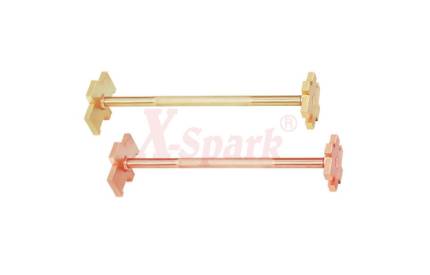When tightening threaded fasteners such as screws, bolts, nuts, etc., explosion wrench needs to control the amount of applied torque to ensure that the thread is tightened and not to damage the thread due to excessive torque, so use a torque wrench to operate. First Set an upper limit for the required torque value. When the applied torque reaches the set value, the wrench will make a "Kata" sound or the angle at which the wrench joint is bent a little, which means it is already tightened and no more force is required.
Because copper itself is relatively soft, it has a good concession during friction and impact, and it is not easy to generate tiny metal particles. Therefore, we can hardly see sparks, so explosion-proof tools are also called non-sparking tools. When ordinary tools and carbon steel pipe bolts come into contact with each other, they will generate static electricity and impact sparks. They cannot be used in flammable and explosive places. Non-sparking wrench and carbon steel impact do not generate static electricity and sparks, so it is explosion-proof.

Explosion Wrench
1. When using an explosion-proof wrench, select an appropriate range according to the needs of the measuring parts. The torque value to be measured must be greater than one-fifth of the range of the torque device in use. If the range is too large, it cannot be used to strengthen small torque parts. .
2. Connect the supporting pawl with auxiliary accessories to ensure that there are no problems in the connection. Before strengthening the torque, set the force value that needs to be reinforced and lock the locking device, and then adjust the direction switch to the direction
3. When taking the measurement, the hand should hold the effective range of the handle and slowly increase the force in the direction of the pipe along the vertical direction until you hear the sound made after reaching the set value.
Introduction of common explosion-proof wrenches:
Wrench: A fixed-size opening is made at one or both ends to turn a nut or bolt of a certain size.
Torx wrench: There are working ends with hexagon holes or twelve corner holes at both ends, which is suitable for situations where the working space is narrow and ordinary wrenches cannot be used.
Dual-use wrench: One end is the same as a single-headed spanner, and the other end is the same as a Phillips wrench, and the two ends are turned with the same specifications of bolts or nuts.
Adjustable wrench: The width of the opening can be adjusted within a certain size range, and it can turn bolts or nuts of different specifications.
Hook wrench: Also known as a crescent wrench, used to turn flat nuts with a limited thickness.
Socket wrench: It consists of multiple sockets with hexagonal holes or twelve corner holes, and is equipped with a variety of accessories such as handles and posts. It is especially suitable for turning bolts or nuts with very narrow positions or deep recesses.
Allen wrench: L-shaped hexagonal rod wrench, special for turning allen screws. The model of the Allen wrench is according to the size of the opposite sides of the hexagon. The size of the bolt has national standards.
Hexagon wrench use: Specially used for tightening or removing round nuts on machine tools, vehicles, machinery and equipment.
Torque wrench: It can display the applied torque when turning the bolt or nut; or when the applied torque reaches the specified value, it will emit a light or sound signal. The torque wrench is suitable for installations with a clearly defined torque.
Purpose of the adjustable wrench: The structure of the wrench is characterized in that the fixed jaw is made of a flat jaw with fine teeth; one end of the movable jaw is made of a flat jaw; the other end is made of a concave jaw with fine teeth; downward Press the worm, the movable jaw can be quickly removed, and the position of the jaw can be changed.
评论
发表评论